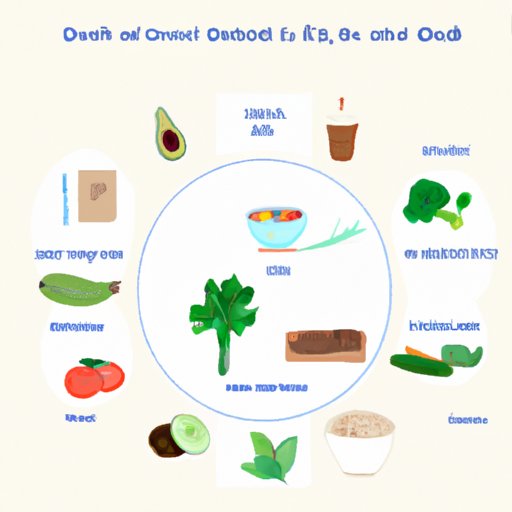Introduction
Eating a healthy diet is essential for maintaining optimal physical and mental health. It can help reduce the risk of developing certain diseases, as well as boost energy levels, improve mood, and promote overall wellbeing. This article provides a comprehensive guide to understanding what is healthy to eat, and how to plan balanced meals and eat out healthily.
An Overview of Nutritional Guidelines for Healthy Eating
The first step to understanding what is healthy to eat is to become familiar with the basics of nutrition. The World Health Organisation defines nutrition as “the science that interprets the interaction of nutrients and other substances in food in relation to maintenance, growth, reproduction, health and disease of an organism” (WHO, 2020).
A balanced diet consists of a variety of foods from each of the main food groups: carbohydrates, proteins, fruits, vegetables, dairy and fats. These are known as macronutrients; micronutrients include vitamins and minerals which are also important for good health.
The U.S. Department of Agriculture (USDA) recommends consuming the following daily proportions of each food group (USDA, 2020):
- Fruits: 1.5-2 cups
- Vegetables: 2-3 cups
- Grains: 6 ounces
- Proteins: 5.5 ounces
- Dairy: 3 cups
- Oils: 27 grams
A Guide to Planning Balanced Meals
Once you understand the basics of nutrition and the recommended proportions of each food group, it is time to start planning your meals. Combining foods from different food groups helps to ensure that you get a good balance of nutrients in each meal. For example, a balanced lunch could include a portion of lean protein such as fish or chicken, alongside a side of vegetables, wholegrain rice and a small portion of fat such as avocado.
It is also important to think about portion sizes. The USDA suggests that a single portion should be around one cup for fruits and vegetables, and three ounces for proteins (USDA, 2020). Eating too much of any one food group can lead to an imbalance in your diet, so it is important to keep track of portion sizes.
Finally, it is important to make sure that you are getting the right balance of macronutrients and micronutrients in each meal. Macronutrients provide energy, while micronutrients are essential for the body to function properly. Aim to include a variety of different fruits and vegetables in your diet, as they contain a range of vitamins and minerals which are essential for good health.

Making the Most of Superfoods
Superfoods are nutrient-dense foods which are packed with vitamins and minerals. They have been linked to a range of health benefits, such as improved digestion, increased energy levels, and a lower risk of disease. Some examples of superfoods include blueberries, spinach, salmon, quinoa, and chia seeds.
Incorporating superfoods into your diet can help to ensure that you get the vitamins and minerals you need for good health. Try adding a handful of blueberries to your morning smoothie, or swapping white rice for quinoa in your stir fry. Even small changes can make a big difference to your overall health.

Exploring Different Diets and their Health Benefits
There are a number of different diets which are popular for their health benefits. These include vegetarianism, veganism, the Paleo Diet, and the Gluten-free Diet. While each of these diets has its own set of guidelines, they all focus on consuming whole, unprocessed foods which are low in sugar and saturated fats.
Vegetarianism is a diet which excludes meat, fish and poultry, but allows for the consumption of eggs and dairy products. Studies have shown that vegetarians tend to have lower levels of cholesterol, blood pressure and body mass index than non-vegetarians (Craig et al., 2009).
Veganism is similar to vegetarianism, but excludes all animal products, including eggs and dairy. Studies have found that vegans tend to have lower levels of cholesterol and blood pressure than both vegetarians and non-vegetarians (Craig et al., 2009).
The Paleo Diet focuses on eating whole, unprocessed foods which were available to our hunter-gatherer ancestors. This includes fruits, vegetables, nuts, seeds, and lean proteins such as fish and poultry. Studies have shown that following a Paleo Diet can lead to improved blood sugar control and weight loss (Cordain et al., 2002).
Finally, the Gluten-free Diet is designed for people with celiac disease, an autoimmune disorder which causes damage to the small intestine when gluten is consumed. Following a gluten-free diet can help to reduce symptoms of celiac disease and improve overall health (Green et al., 2012).

Tips for Eating Out Healthily
Eating out can often be an unhealthy experience, particularly if you don’t know which restaurants offer healthier options. Here are some tips to help you make healthier choices when eating out:
- Choose healthier menu options such as salads, soups, and grilled proteins.
- Look for restaurants which offer lighter options, such as sushi bars and juice bars.
- Avoid deep fried and heavily processed foods such as french fries, burgers and pizza.
- Opt for healthier sides such as steamed vegetables or a side salad.
- Ask for sauces and dressings to be served on the side, and limit your intake of these.
Conclusion
Eating a healthy diet is essential for maintaining optimal physical and mental health. This article has provided a comprehensive guide to understanding what is healthy to eat, and how to plan balanced meals and eat out healthily. By becoming familiar with the basics of nutrition, combining foods from different food groups, and making the most of superfoods, you can ensure that you get the vitamins and minerals you need for good health.
(Note: Is this article not meeting your expectations? Do you have knowledge or insights to share? Unlock new opportunities and expand your reach by joining our authors team. Click Registration to join us and share your expertise with our readers.)
